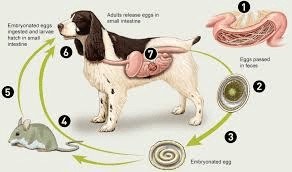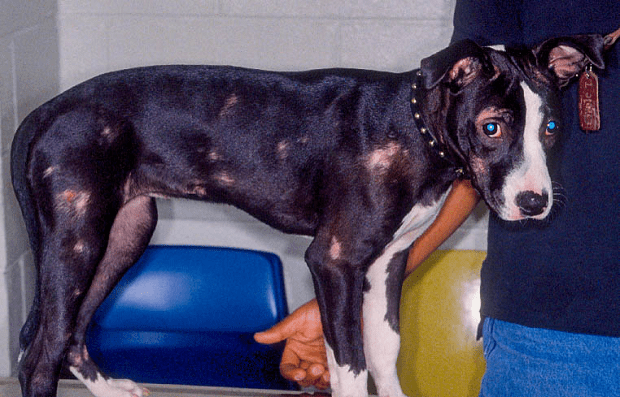In keeping with this week’s discussion of parasitism, this article addresses roundworms in dogs and puppies.

There are two species of roundworms affecting dogs and puppies: Toxocara canis and Toxascaris leonina. Both are treated with the same medication protocol so when eggs are seen on a fecal flotation exam, it may not be necessary to determine which species is present.
While T. canis infects only dogs, T. leonina is also able to infect cats and kittens. Treatment protocols for both worm species is the same but if there are feline household members, it may be useful to specifically identify the roundworm species involved so as to determine which pets are potentially at risk. We will cover each species of roundworm separately for, even though treatment is the same for each, their biology is different.
Fresh feces are not infectious. Fresh feces do not contain the infectious stage of T. Canis. Worm eggs require 30 days to become infectious, meaning it is contaminated dirt that is infectious to people and animals.
Toxocara Canis: How Infection Occurs

T. canis is the most common roundworm of the domestic dog, and it is not able to infect cats. Its presence can go completely without symptoms although more likely it is going to create some degree of diarrhea and possibly vomiting or general unthriftiness in its canine host. Its life cycle is somewhat complicated, as we are about to see.
- Consuming infective worm eggs from soil in the environment (generally through normal grooming//self-licking).
- Nursing from an infected mother dog.
- Consuming a prey animal (usually rodent) that is carrying developing worms.
- During embryonic development when an infected mother dog is pregnant (most puppies are infected this way).
Cats cannot be infected with Toxocara canis but humans can.
Life As A Roundworm
T. canis has one of the most amazing life cycles in the animal kingdom. It is helpful to understand this life cycle if effective treatment and prevention are to be pursued.
- Eggs Contaminate Environmental Soil
- A Host Eats an Egg and the Larva Encysts
- The Larva Awakens and Migrates Through the Host
- Finally Back in the Intestine and Ready to Settle Down

Step One
Toxocara eggs are passed in the host’s feces where they can be detected if a fecal sample is tested. Feces, and any worms eggs therein, are deposited on the ground where they are rained on, dried by the sun, stepped on, etc. The worms are developing during this time and are not infectious to new hosts until they have developed for about a month. By that time, the original feces has long since melted away into the ground and is no longer evident. It is the dirt that contains infectious eggs. Toxocara eggs are famous for weathering harsh environmental conditions. Eggs can remain infective for months to years.
Fresh feces are not infectious. Soil contaminated with feces is infectious.
Step Two
The egg containing what is called a second stage larva is picked up from the dirt by a dog or by some other animal, usually in the course of normal self-grooming. The egg hatches in the new host’s intestinal tract and the young worm burrows its way out of the intestinal tract to encyst in the host’s other body tissues. If the new host is a dog, the life cycle proceeds. If the new host is a member of another species, the larvae wait encysted until the new host is eaten by a dog.
Step Three
These second stage larvae can remain encysted happily for years. If the host is a puppy under age 6 months of age, the larvae mostly encyst in the host’s liver. In older dogs, the larvae encyst all over the body. When the time comes to move on, the larvae excyst and migrate to the host’s lungs where they develop into third stage larvae. They burrow into the small airways and travel upward towards the host’s throat. A heavy infection can produce a serious pneumonia. When they get to the upper airways, their presence generates coughing. The worms are coughed up into the host’s throat where they are swallowed thus entering the intestinal tract for the second time in their development.
If the host is pregnant, the larvae do not migrate to the lung after they excyst; instead they home to the uterus and infect the unborn puppies. The second stage larvae make their way to the puppies’ lungs to develop into third stage larvae.

If the host is a nursing mother, she secretes third stage larvae in her milk for the first 3 weeks after giving birth. These larvae simply find themselves in the puppy’s intestinal tract where, at this stage, they do not need to migrate but can settle in and begin mating. Puppies can be infected by drinking their mother’s milk, though, due to the intrauterine cycle described above, the litter would probably already be infected.
Note: When dogs are dewormed with traditional dewormers, this affects only worms in the intestinal tract. It does not affect encysted larvae. It is difficult to prevent mother-to-puppy transmission and routine deworming is not adequate. It is possible to prevent infection in unborn puppies by using a specific daily protocol of fenbendazole (your veterinarian can provide details) or with selamectin (Revolution®).
Step Four
Once back in the intestine, the larvae complete their maturation and begin to mate. The first eggs are laid about one week after the larvae have arrived in the intestine and finished molting into their adult stages (about 4 to 5 weeks after infection has first occurred). From here the cycle repeats.
Why Is Infection Bad?
Roundworm infection can have numerous negative effects. It is a common cause of diarrhea in young animals and can cause vomiting as well. Sometimes the worms themselves are vomited up which can be alarming as they can be quite large with females reaching lengths of up to seven inches. The worms consume the host’s food and can lead to unthriftiness and a classical “pot-bellied” appearance. Very heavy infections can lead to pneumonia as the worms migrate and, if there are enough worms, the intestine can actually become obstructed.
It should also be noted that human infection by this parasite is especially serious (see below). It is important to minimize the contamination of environmental soil with the feces of infected animals so as to reduce the exposure hazard to humans and other animals. In other words, dog feces should be removed and discarded promptly before worm eggs permanently contaminate the local dirt.
How Do We Know If Our Dog Is Infected?
Of course, there are ways to find out if your dog is infected. If a dog or puppy vomits up a worm, there is a good chance this is a roundworm (especially in a puppy). Roundworms are long, white and described as looking like spaghetti. Tapeworms can also be vomited up but these are flat and obviously segmented. If you are not sure what type of worm you are seeing, bring it to your veterinarian’s office for identification.You may not know if your dog is infected, and this is one of the arguments in favor of regular deworming. Regular deworming is especially recommended for dogs that hunt and might consume the flesh of hosts carrying worm larvae. Puppies are frequently simply assumed to be infected and automatically dewormed.
Fecal testing for worm eggs is a must for puppies and a good idea for adult dogs having their annual check up. Obviously, if there are worms, they must be laying eggs in order to be detected, but by and large fecal testing is a reliable method of detection.


